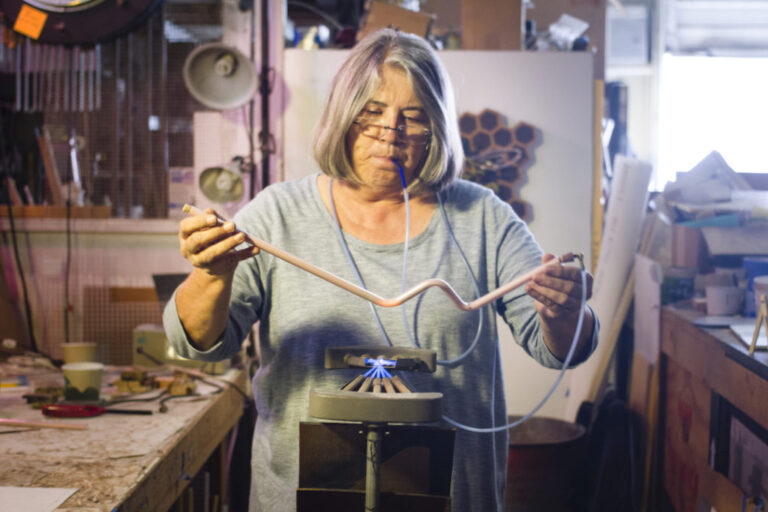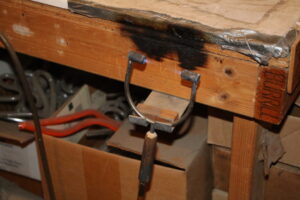
2016…
I have been bending for about eleven years studying with Michael Flechtner. I decided to write about the process so that I wouldn’t forget all the lessons along the way.
The basics… there are three fires that one works in—a ribbon burner, a cross fire and a hand torch. To bend, you start with a 4 foot straight piece of glass that can be trimmed for a specific pattern. You then put a cork in one end and the rubber end of the blow hose into the other end. The blow hose is used to blow air into the tube while it is heating so that the tube doesn’t collapse. Then you move the tube into the fire for heating. The goal is to heat the right amount of glass for the bend you are making, get it hot enough and heat it evenly by rotating the glass or the hand torch.

Plan B 7, Linda Sue Price
When I first started to learn how to bend my intention was to bend free form. However, in order to get in touch with the glass I had to practice bending to pattern. Pattern bending comes from the head whereas freeform comes from the gut.
When bending freeform I feel very connected to the glass. It’s like having a conversation with the glass. Some times the communication flows and other times not.
Pattern bending is another issue. But finally after years of practice and the desire to be able to create specific forms, I am now learning how to surrender to the pattern. There are so many things to consider when bending to pattern—how you go into the fire and come out of it so you are positioned to land easily on the pattern.

Pattern for bending
Other challenges I faced was under heating and twisting the glass. The idea is to heat the right amount of glass for the bend you are making, get it hot enough and heat it evenly.
There are three types of fires used to heat the glass. The ribbon burner—my favorite—for making loop shapes; the cross fire for specific small movements like V’s, U’s, and L’s; and the hand torch for delicate work like attaching electrodes or making small adjustments. The hand torch has less heat so it’s ideal for small, delicate corrections.
In the beginning I started to under heat the glass because when the glass was at the right heat it was too easy to accidentally stretch the glass. By under heating I eliminated the stretching but then I got kinks because the glass wasn’t hot enough.
Once I started getting the glass hot enough, I struggled with over inflation. Part of the process of bending is having a blow hose attached so you can inflate the glass when it gets hot to keep it from collapsing.

Blow hose used in neon bending
Then In my pattern practice, I struggled with making U bends without getting kinking on the inside. I discovered that I was twisting the glass coming out of the fire. It would look great when I came out of the fire but by the time I got it to the pattern on the workbench, it would kink. After some focused practice I figured out that I was twisting the glass so I spent practice time breaking that habit.
There is no scientific process to this. It is just hours of practice and learning to read the glass. And each time you figure out what you are doing wrong, to fix that you have to relearn the bending process.
Then there is the mind. If you over concentrate on the bend you lose it. If you don’t focus you lose it so you have to find the balance. Listening to music while bending helps but some times I start dancing to the music and get distracted.
Currently I’m practicing a pattern and attempting to bend to it. I’ve spent a month or so trying to get the hang of it. I’m in the studio two to three days a week and each week it gets better but bending to pattern is so different. Tonight I began to think—why am I doing this. No one will appreciate how much harder this is for me than the complex free form bends I do. But I am keeping at it. It looks like a simple pattern but it’s really challenging.
After another month of practice and more demos by the master, I had success. The bends went the way they were supposed to and the tube was smooth—no crunches and on pattern. Amazing.

Curves Ahead, Linda Sue Price.
2019 update…
I have calculated that I have completed about 2300 of the required 10,000 hours required to become a master. In light of that, I am pretty pleased with where I am.
I have been doing project bending the past couple weeks as opposed to practice bending. Generally that makes me tense especially when I work with the ‘good’ aka expensive glass. But after considering that I don’t have 10,000 hours I feel like I need to channel my efforts to combat my bending anxiety. So I’m trying to use my yoga meditation skills, self-acceptance/forgiveness and monitoring the conversations in my head in an attempt to chill the distractions.
Feb 2019:
I started counting the rotations I was making in the fires. Depending on the weather, in the ribbon burner, so far—it has ranged from 10 to 14. Counting helps me stay in focus and when I drift I come back knowing where I am in the rotation. It seems to be helping.



Different types of burners used in neon bending. From left to right: cross fire, ribbon burner, and hand torch
March 2019:
Haven’t bent in a month. Anxious. Had the fires on for three hours but only spent an hour actually bending. I was very distracted. In practice bending, 10 mm looked fine, 12 mm was trash. Next day… started with 12 mm. Not great but better and then moved to testing the waters on the forms I wanted to bend. First several went well. So I started relaxing which helped my focus.
Came back from lunch and the tube that blew up on me a month ago, the new tube blew up again on the 5th bend again. Changed strategies… simplified the idea and didn’t let the glass cool completely between bends. That worked and I ended the day feeling confident that my skills are moving forward.
I’ve also started using the same strategy in free form as I do in pattern bending which is to figure out how to get into the fire so that I can easily make the rotations, what position does the glass need to be when coming out of the fire and eliminating any awkwardness such as the blow hose getting in the way. Combined with counting the rotations, my bending is having a much improved flow.

Question, Think, Listen by Linda Sue Price
February 2020…
In my warm up and practice bending, I’ve been doing a sequence of 8 double back bends for years. I have finally gotten past the kinking and now moving on to inflating which means I have to get the glass hot enough. I noticed recently that when I’m in the ribbon burner I get the glass a lot hotter so I am going to work on getting the glass hotter in the cross fire. The challenge will be to not overheat it and cause the glass to seize.
March 1, 2020…
When I bend free form I look at and feel the glass in a way that I know when it has released. In pattern bending I haven’t been doing that. So today and yesterday, I was still not kinking the glass but the U bends were screwy so I eventually backed off and started trying to look and feel the glass and make the necessary adjustment and get some good bends.

Plan B 3, Linda Sue Price
March 26, 2020…
It turns out that I was heating too much glass and then was not in the center of the fire. After two or three weeks of trying different heats, I recalled Michael saying… if it is not working try something different so I moved the glass closer to me in the cross fire and suddenly I was able to make the U bend with no kinks, no funky shape and get the necessary inflation. Part of this change is due to new protective glasses that I got that weren’t as dark as my previous ones which changed my perception but it was scary because it felt like my skills were deteriorating. With the darker glasses I was getting clean bends but couldn’t inflate. It is such a delicate space. Every little adjustment has consequences.
So I’ve moved on to the next challenge of welding using the hand torch. I haven’t worked with the hand torch much. It’s different because instead of rotating the glass you are rotating the torch. I nailed two and blew about five. The body positioning is different from the other fires. Learning continues. Michael demoed the sequence again for me. This time I videotaped it. The challenge is finding a body position that is comfortable.



From left to right: Plan B 6, Turn Left, Gratitude is a Virtue, Linda Sue Price.
